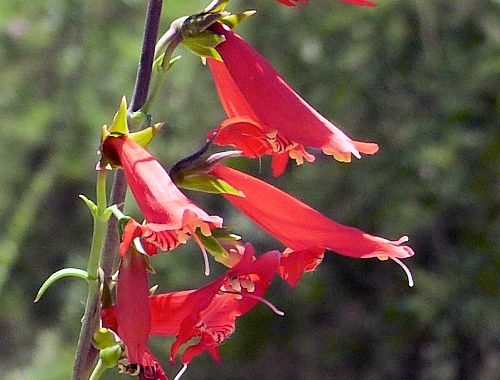Growing Penstemon barbatus:
Beardlip Penstemon
Description
Form: Herb.
Lifespan: Perennial.
Growth rate: Moderate.
Mature Size: Beardlip Penstemon has a rosette of leaves 6" (15cm) high and 24" (60cm) wide at its base. The flower stalk grows as high as 36" (90cm).
Flowers: Red to red-orange, tubular, 1.5" (3.8cm) long, with a double lower lip curved back, arrayed on spikes. The sterile stamen on its lower lip is hairy, although barely noticeable in some specimens.
Bloom: Mid-spring to mid-summer, or later in more northern locations.
Fruit: Seed capsule.
Leaves: Linear to lance-shaped, green to blue-green.
Stems: Tall, vertical, often reddish.
Roots: Non-invasive.
Wildlife: The flowers attract hummingbirds and large butterflies. This plant is usually ignored by rabbits and other mammals when it is not watered.
Toxic / Danger: No.
Origin: Utah, Colorado, Arizona through Texas, and Mexico.
Form: Herb.
Lifespan: Perennial.
Growth rate: Moderate.
Mature Size: Beardlip Penstemon has a rosette of leaves 6" (15cm) high and 24" (60cm) wide at its base. The flower stalk grows as high as 36" (90cm).
Flowers: Red to red-orange, tubular, 1.5" (3.8cm) long, with a double lower lip curved back, arrayed on spikes. The sterile stamen on its lower lip is hairy, although barely noticeable in some specimens.
Bloom: Mid-spring to mid-summer, or later in more northern locations.
Fruit: Seed capsule.
Leaves: Linear to lance-shaped, green to blue-green.
Stems: Tall, vertical, often reddish.
Roots: Non-invasive.
Wildlife: The flowers attract hummingbirds and large butterflies. This plant is usually ignored by rabbits and other mammals when it is not watered.
Toxic / Danger: No.
Origin: Utah, Colorado, Arizona through Texas, and Mexico.
Cultivation and Uses
USDA hardiness zones: 4-9.
Heat tolerant: Yes.
Drought tolerant: Yes.
Sun: This plant needs full sun and high temperatures for the most blooms, but will tolerate part shade.
Planting: Locate in an area with all day full sun and well draining, poor soil. Do not add soil amendments. Surround with small gravel. This plant can be grown in a container.
Soil: Well draining, dry, low organic content, pH 6.1-7.8 (slightly acidic to slightly alkaline). Do not fertilize.
Water once established: Once or twice a month.
Mulch: Use decomposed granite or small gravel to shade the root area from direct sun and high temperatures.
Prune: Remove spent blossom stalks at the start of seed formation to encourage new growth.
Litter: Low.
Propagation: Seed planted in the fall; cuttings of new growth in spring; half-woody basal cuttings from non-flowering stems mid-summer; root division in the spring.
Uses: Ornamental, low water (xeriscape) garden.
USDA hardiness zones: 4-9.
Heat tolerant: Yes.
Drought tolerant: Yes.
Sun: This plant needs full sun and high temperatures for the most blooms, but will tolerate part shade.
Planting: Locate in an area with all day full sun and well draining, poor soil. Do not add soil amendments. Surround with small gravel. This plant can be grown in a container.
Soil: Well draining, dry, low organic content, pH 6.1-7.8 (slightly acidic to slightly alkaline). Do not fertilize.
Water once established: Once or twice a month.
Mulch: Use decomposed granite or small gravel to shade the root area from direct sun and high temperatures.
Prune: Remove spent blossom stalks at the start of seed formation to encourage new growth.
Litter: Low.
Propagation: Seed planted in the fall; cuttings of new growth in spring; half-woody basal cuttings from non-flowering stems mid-summer; root division in the spring.
Uses: Ornamental, low water (xeriscape) garden.
Comments
This plant is a member of the Penstemon and Plantain family (Plantaginaceae). Other common names are Golden Beard Penstemon and Beard Tongue Penstemon. This plant expects poor soil, infrequent water, full sun, and high temperatures. The best way to keep it from flowering is to fertilize it, put it in the shade, or water it more than twice a month (except for new plantings).
Do you have additional information or a different experience for these plants that you would like to share? Email info@GardenOracle.com. All contributions are welcome and appreciated.
This plant is a member of the Penstemon and Plantain family (Plantaginaceae). Other common names are Golden Beard Penstemon and Beard Tongue Penstemon. This plant expects poor soil, infrequent water, full sun, and high temperatures. The best way to keep it from flowering is to fertilize it, put it in the shade, or water it more than twice a month (except for new plantings).
Do you have additional information or a different experience for these plants that you would like to share? Email info@GardenOracle.com. All contributions are welcome and appreciated.


Latest update: September, 2024
© 2008-2025 by GardenOracle.com

